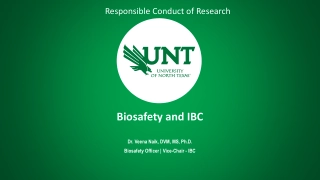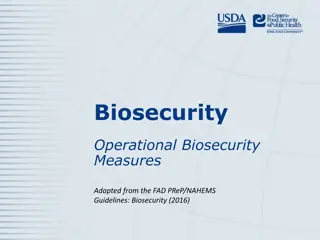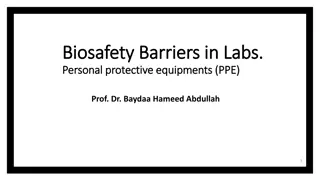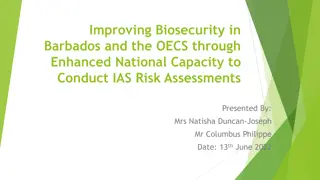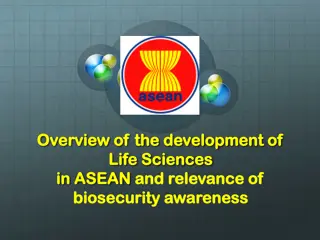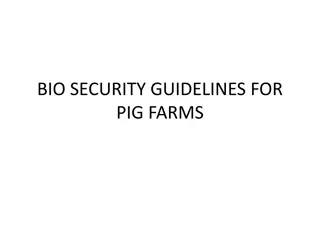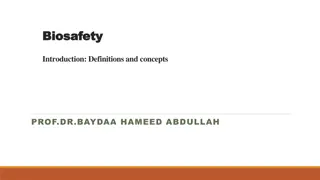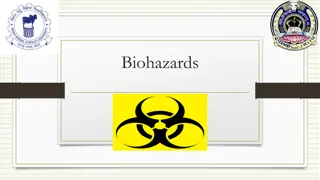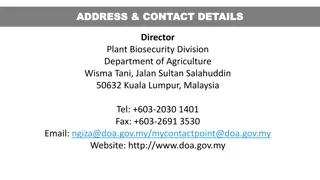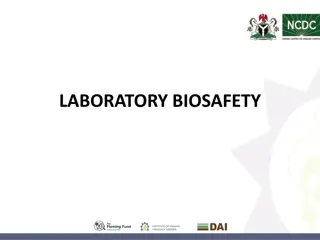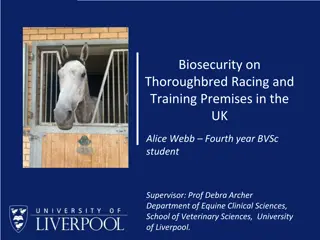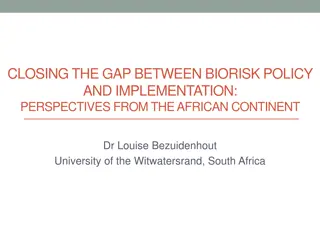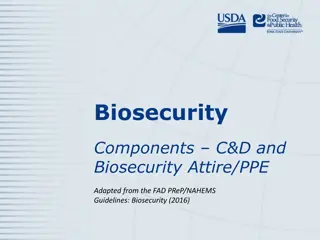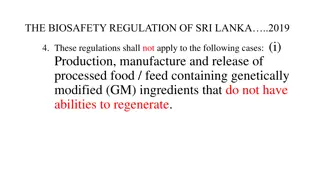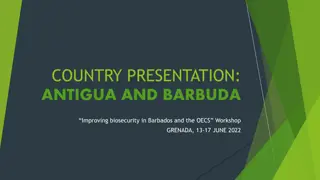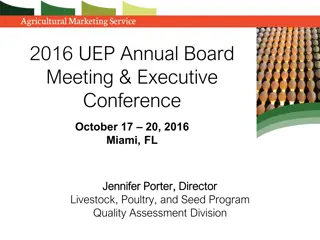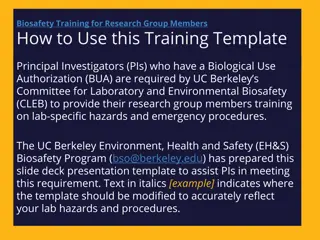Overview of Biosafety and Biosecurity in Global Health Security
The paper delivered at the 2022 Scientific Workshop highlights the importance of biosafety and biosecurity in the face of emerging infectious diseases. It defines key terms, emphasizes the need for containment procedures to manage biohazards, and addresses the critical pillars of biosafety and biosecurity. The objective is to enhance understanding and reinforce the significance of these measures in combating biological threats globally.
Download Presentation

Please find below an Image/Link to download the presentation.
The content on the website is provided AS IS for your information and personal use only. It may not be sold, licensed, or shared on other websites without obtaining consent from the author. Download presentation by click this link. If you encounter any issues during the download, it is possible that the publisher has removed the file from their server.
E N D
Presentation Transcript
INTRODUCTORY OVERVIEW OF BIOSAFETY AND BIOSECURITY IKPO, PRECIOUS ETINOSA (PhD, AMLSCN) ADMLS/HEAD, MEDICAL LABORATORY UNIT FNPH, BENIN. A PAPER DELIVERED AT 2022 SCIENTIFIC WORKSHOP ORGANISED BY THE MEDICAL LABORATORY UNIT, FEDERAL NEURO-PSYCHIATRIC HOSPITAL , BENIN. 20/10/2022 SCIENTIFIC WORKSHOP 2022 1
OUTLINE Definition of terms Introduction What is Biosafety Components/pillars of Biosafety What is Biosecurity Components of Biosecurity Biosafety level (BSL) Conclusion References 20/10/2022 SCIENTIFIC WORKSHOP 2022 2
OBJECTIVES 1. To understand the concept of biosafety and biosecurity. 1. To re-enforce the need for biosafety and biosecurity in containing biological threats. 20/10/2022
DEFINITION OF TERMS Biological Agents/materials: These are substances that are naturally occurring or synthesized from living organisms such as bacteria, fungi, viruses and their associated toxins with the ability to adversely affect public health. Biological Threats: Are infectious disease with the potential to spread and cause an outbreak of infections e.g Smallpox , Ebola, Anthrax. 20/10/2022 SCIENTIFIC WORKSHOP 2022 4
Infectious diseases: are illnesses caused by micro- organisms. Micro-organism: Tiny invisible living things only visible under the microscope e.g bacteria, fungi. Pathogens: A bacteria, virus or other microorganism that can cause disease. Toxins: A poison of plant or animal origin especially produced by microorganisms and acting as an antigen in the body. 20/10/2022 SCIENTIFIC WORKSHOP 2022 5
Bio-hazards: Biological agents from either animal, plant such as bacteria, virus, wild animals, contaminated sharp objects that can cause harm to human, animal and the environment. Containment: is the term used to describe methods, practices, procedures, facilities, and equipment used to safely manage bio-hazardous materials. (CDC,2020.) 20/10/2022 SCIENTIFIC WORKSHOP 2022 6
INTRODUCTION Global health security is currently a burning issue worldwide. This is primarily because the world is faced with the spread of newly emergent and re-emergence of infectious microorganism. This phenomena is a result of previously uninhabited environments becoming home to human beings with the concomitant exposure to microorganisms resident there. (WHO, 2020) 20/10/2022 SCIENTIFIC WORKSHOP 2022 7
INTRODUCTION CONTD Furthermore, the increased interactions due to globalization, ease of travel and the world's population explosion, has led to a rise in biological threats. The resultant effect is adverse on personal well-being and social stability. 20/10/2022 SCIENTIFIC WORKSHOP 2022 8
INTRODUCTION CONTD A very recent global example is the sudden emergence of COVID-19 pandemic in 2019 which was considered an international Biosafety incident. (WHO, 2020). 20/10/2022 SCIENTIFIC WORKSHOP 2022 9
This Places necessity on strengthening Biosafety/Biosecurity policies, principles and practices in the workplace especially in health facilities and biological research laboratories across the world. (WHO, 2020). 20/10/2022 SCIENTIFIC WORKSHOP 2022 10
WHAT IS BIOSAFETY According to World Health Organisation (WHO), Biosafety is the safe working practices associated with the handling of biological materials, particularly infectious agents. 20/10/2022 SCIENTIFIC WORKSHOP 2022 11
Biosafety is a set of precautionary approach/ principles, technologies and practices that are implemented to prevent the unintentional or accidental release or exposure to pathogens and toxins. Biosafety seeks to protect the personnel, patients (where applicable), entire community from harmful biological agents. (WHO,2016 ). 20/10/2022 SCIENTIFIC WORKSHOP 2022 12
Failures to follow such protocols can lead to increased risk of exposure to biohazards or pathogens. Research has shown that human error and poor technique contribute to unnecessary exposure and compromise the best safeguards set into place for protection from biohazards. 20/10/2022 SCIENTIFIC WORKSHOP 2022 13
Biosafety is applicable to several fields viz: Medicine, Agriculture, Ecology, Engineering, Research institutions especially where synthetic biology is of essence, teaching and production facilities where work is performed with infectious agents that may cause serious or potentially lethal diseases. 20/10/2022 SCIENTIFIC WORKSHOP 2022 14
COMPONENTS (5 PILLARS) OF A BIOSAFETY PROGRAM Comprehensive Training Program Medical Surveillance Emergency Response Plan Standard Operating Procedures Biosecurity Plan ( Lela et al.,2010). 20/10/2022 SCIENTIFIC WORKSHOP 2022 15
Comphrensive Training Program: This training is done for individuals working with microorganisms or human blood, cell lines or other potentially infectious human material. Medical surveillance: This is the systematic assessment of employees exposure or potential exposure to occupational bio-hazards. 20/10/2022 SCIENTIFIC WORKSHOP 2022 16
It monitors individuals for adverse health effects and determines the effectiveness of exposure, prevention strategies. Identifying workers for whom surveillance is needed. Identifying potential hazards and exposure risk. Select and conduct appropriate test examination. 20/10/2022 SCIENTIFIC WORKSHOP 2022 17
Emergency Response Plan(ERP): Is a documented series of steps an organisation will take during a critical event to ensure employees safety and minimize the impact on critical operations. Emergency response plan should contain the following in the event of a bio-emergency: 20/10/2022 SCIENTIFIC WORKSHOP 2022 18
Contact person. Evacuation/exist routes. Precaution and Mitigate protocols. 20/10/2022 SCIENTIFIC WORKSHOP 2022 19
Standard Operating Procedures (SOP): These are safety work guidelines used in handling bio-hazardous materials/agents. Biosecurity Plan: Control measures to prevent the misuse, theft, and intentional release of biological agents. 20/10/2022 SCIENTIFIC WORKSHOP 2022 20
WHAT IS BIOSECURITY Biosecurity is the control of intentional or deliberate release of bio-hazardous materials. It refers to measures that are taken to stop the introduction or spread of harmful organism (viruses , bacteria, etc) to human, animal and plant life in order to minimize the risk of transmission of infectious diseases. 20/10/2022 SCIENTIFIC WORKSHOP 2022 21
Biosecurity is an institutional program which is aimed at reducing the risk of unauthorized access, loss, theft, misuse, diversion or intentional release of valuable biological materials (VBM) to tolerable, acceptable levels. (WHO, 2006). 20/10/2022 SCIENTIFIC WORKSHOP 2022 22
A key factor in biosecurity is Accountability. Accountability ensures that Valuable Biological Materials(VBM) are controlled and traced as intended by formally associating the specified materials with the individuals who provide oversight and are held responsible for them. (WHO, 2006). 20/10/2022 SCIENTIFIC WORKSHOP 2022 23
WHAT ARE VAULABLE BIOLOGICAL MATERIAL ( VBM) VBM are materials that require protection for economic and historical (archival) value. They are materials with the potential to cause harm and whose loss would have negative impact on an institutional research effort and reputation 20/10/2022 SCIENTIFIC WORKSHOP 2022 24
VBMs include toxins, pathogens, non- pathogenic organisms, food, genetically modified organisms (GMOs), cell components, genetic elements and extra terrestrial samples. (WHO,2006). 20/10/2022 SCIENTIFIC WORKSHOP 2022 25
Biosecurity requires systematic engineering, which involves monitoring and warning, detection, traceability, prevention and control, diagnosis and treatment, emergency measures, and other technical aspects. Biosafety and biosecurity are inextricably linked and complementary. (WHO, 2020). SCIENTIFIC WORKSHOP 2022 20/10/2022 26
They mitigate different risk with different legal, policy and regulatory regimes. Biosafety and Biosecurity both aim to keep dangerous pathogens safe and secure inside the area where they are used and stored. 20/10/2022 SCIENTIFIC WORKSHOP 2022 27
In a broad sense, Biosafety and Biosecurity enhance the ability to respond effectively to biological threats. 20/10/2022 SCIENTIFIC WORKSHOP 2022 28
Figure: shows a schematic representation of the complementarities and differences between biosafety and biosecurity with a common central goal: the protection of the VBM from misuse. SCIENTIFIC WORKSHOP 2022 29 20/10/2022
A common term used in discussing biosafety and biosecurity is Biorisk. Biorisk encompasses Biosafety and Biosecurity. Biorisk can be defined as the combination of the probability of occurrence of harm and the serverity of harm where the source is a biological agent or toxin. (Lentzos et al., 2022). 20/10/2022 SCIENTIFIC WORKSHOP 2022 30
The reduction of biological risk involves creating expertise in managing high consequence pathogens, by providing training on safe handling and control of pathogens that pose significant health risk. Biosafety + Biosecurity = Biorisk Management. Biorisk Management = Risk assessment, mitigation, performance (WHO, 2007). SCIENTIF IC WORKSHOP 2022 20/10/2022 31
20/10/2022 SCIENTIFIC WORKSHOP 2022 32
BIOSECURITY COMPONENTS To achieve the objective of biosecurity which is protection against loss, theft, misuse, diversion, or intentional release, three (3) components must be put in place viz: Physical Security, Personnel Reliability and Information Security. 20/10/2022 SCIENTIFIC WORKSHOP 2022 33
These components broken into 5 pillars of biosecurity program . The 5 pillars of biosecurity program are Inventory process, physical security, personal reliability program, transport programs, and information security processes. 20/10/2022 SCIENTIFIC WORKSHOP 2022 34
Physical security: This focuses on preventing unauthorized access to biological facilities and ensuring only appropriate people within the facility can access agents. Personnel reliability: This ensures that all staff at the biological facility are responsible and are suitable to work with sensitive materials 20/10/2022 SCIENTIFIC WORKSHOP 2022 35
Information security: This includes cyber security, ensuring all electronic information is safe from theft or misuse. A biosecurity program should be part of a holistic biorisk management program and can only be effective with the support of management of an institution. 20/10/2022 SCIENTIFIC WORKSHOP 2022 36
20/10/2022 SCIENTIFIC WORKSHOP 2022 37
BIOSAFETY LEVELS (BSL) There are four biosafety levels(BSL-1,2,3,4) each with specific controls for containment of microbes and biological agents Biosafety level in any facility is determined by and the nature of work conducted, infectivity, severity of disease and it's transmissibility. (CDC, 2006). 20/10/2022 SCIENTIFIC WORKSHOP 2022 38
As the BSL increases so does the relative risk of the agent/procedures as well the stringency of procedures and facility design. Biosafety leveling is a risk reduction strategy that employs a systematic approach to disrupting the chain of infection. 20/10/2022 SCIENTIFIC WORKSHOP 2022 39
20/10/2022 SCIENTIFIC WORKSHOP 2022 40
CONCLUSION Biosafety and Biosecurity are containment strategies of public health importance. Biosafety and Biosecurity programs help prevent and control the spread of infectious diseases. 20/10/2022 SCIENTIFIC WORKSHOP 2022 41
It provides defensive actions against the deliberate misuse or abuse of biological agents for negative vices such bioterrorism. The committment of Policy makers at the state, nation and international level is key to achieving biosafety and biosecurity . 20/10/2022 SCIENTIFIC WORKSHOP 2022 42
REFERENCES BagheriNejad, S., Allegranzi, B., Syed, S. B., et al. (2011). Healthcare Associated Infection in Africa: a systematic review. WHO; 89:757 765. Lentzos, F., Koblentz, G. D., Rodgers, J. (2022). The Urgent Need For An Overhaul Of Global Biorisk Management. Ctc sentinel.West point New York. 20/10/2022 SCIENTIFIC WORKSHOP 2022 43
Lela, B., Paata, I., Dana, P. (2010). Biosafety And Biosecurity As Essential Pillars Of International Health Security And Cross-cutting Elements Of Biological Non proliferation. British Medical Journal Public Health: 20:10-16. World Health Report 2002. Reducing Risks, Promoting Healthy Life. World health Organization, Geneva. (Accessed 12 June 2015). 106. 20/10/2022 SCIENTIFIC WORKSHOP 2022 44
THANKS FOR LISTENING 20/10/2022 SCIENTIFIC WORKSHOP 2022 45





